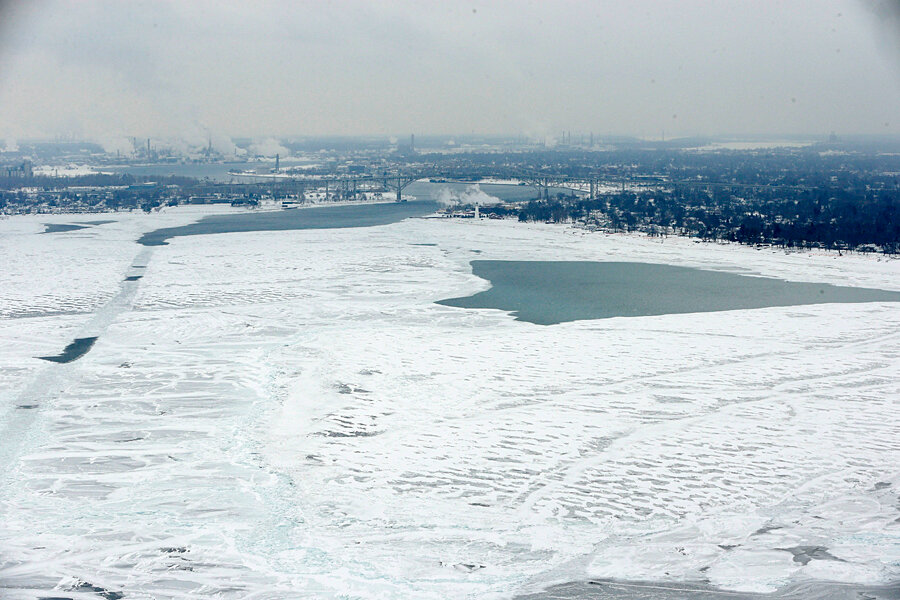Great Lakes nearing a record for ice, with more winter ahead
Loading...
| Chicago
Ice-fishing enthusiasts of the upper Midwest are ecstatic. So is anyone who worries about the trend of lower water levels on the Great Lakes. And wildlife conservationists are delighted, too, citing benefits to cold-water fish species and even, perhaps, to a group of endangered wolves. As for barge operators? Not so much.
The winter of 2013-14 has brought ice to the Great Lakes – lots of it, to the growls of some and to the cheers of others. Four of the five lakes are almost at record-setting levels of ice, nearing a milestone set in 1979, the year of one of the region's most treacherous blizzards. That year, 95 percent of the lakes' surfaces were sheeted in ice.
In total, about 88 percent of the lakes' total surface is currently ice-covered, reports the National Weather Service’s Great Lakes Environmental Research Laboratory in Ann Arbor, Mich. Lake Erie is 96 percent covered, followed by Lakes Huron and Superior at about 95 percent each. Lake Michigan is lower, at 82 percent, and Lake Ontario’s ice mass is at just 43 percent. The Great Lakes hold nearly one-fifth of the planet's fresh water.
“Historically … it’s the second-largest accumulation by this date. It’s not usual to get this much ice this early,” Mark Gill, director of vessel traffic for the US Coast Guard, told the Northwest Indiana Times Friday.
Bitter cold temperatures, which started early this winter, are largely responsible. In typical winters, ice tends to peak by mid- to late-February in the lower Great Lakes, and by late February to early March in Lake Superior, to the north. Normal mid-February ice total for the Great Lakes is 32 percent, says George Leshkevich, a physical scientist with the Great Lakes Environmental Research Laboratory.
“The ice season started earlier this year because of the cold temperatures we had in the fall and early winter. We had reports of ice in bays and harbors as early as the end of November instead of mid-December, normally,” Mr. Leshkevich says. “And then, of course, the Arctic vortex kept building that ice.”
Perhaps the biggest benefit of the ice buildup will accrue to water levels. For two decades, water levels have been falling in the Great Lakes, and the US Army Corps of Engineers says Lake Huron and Lake Michigan last year hit their lowest points since record-keeping began in 1918 (29 vertical inches below their long-term averages). Lakes Superior, Erie, and Ontario are also well below average levels.
The ice cover helps because it will keep the lakes cool for much longer, reducing and inevitably delaying evaporation, the leading culprit in the problem. Studies show that evaporation and ice cover regulate the lakes' water levels. But the natural 10-year cycle of rising and falling water levels in the Great Lakes has been interrupted since 1998 because of distant atmospheric trends – with the result that water levels have fallen significantly, according to a report published last month by the Wisconsin Department of Natural Resources.
Ice-encased lakes can also benefit certain wildlife, at least temporarily. In heavy ice, eggs of cold-water fish species are more protected from predators. And a pack of wolves living in Isle Royale National Park, set on an island in the northwest corner of Lake Superior, may be able to gain a safe passageway across an ice bridge to Ontario, say park biologists. The natural ice bridge has eroded in recent years, so the wolves have become isolated and their numbers have declined. Only eight remain, according to a report published last year by the Lansing State Journal.
But with shipping lanes in the Great Lakes ice-clogged, the Coast Guard has dispatched vessels this week to work nonstop to keep commerce moving. Commercial ships haul bulk commodities across the lake region, and iron ore for the steel plants along the Indiana and Michigan coast. The Coast Guard has requested additional ice-breaking technology from Canada, and it is expected to arrive in March. To break the ice, which can be several feet thick, vessels can move backwards to chop it with propeller blades, use the weight of the bow to loosen it, and spin special thrusters downward into it.
“It’s a tremendous challenge this winter,” Mr. Gill says. "It's been much slower than normal for the shipping industry.… Three-day trips from Duluth, [Minn.] to Indiana Harbor have taken nine days. That's three trip opportunities – three trips they could have gotten in.”






